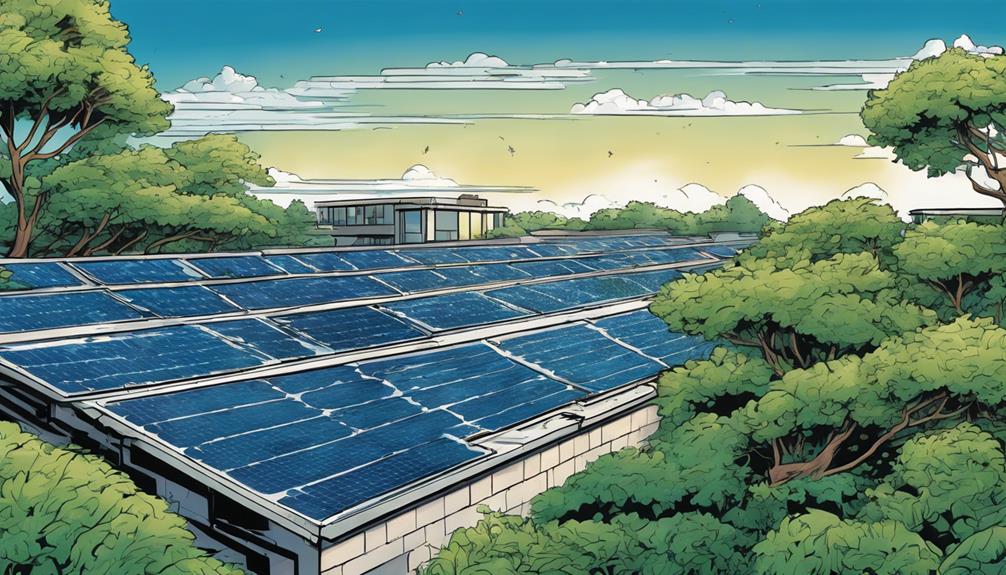I've seen how solar farms can revolutionize local economies, generating billions in revenue and creating thousands of jobs. In rural areas, they stimulate economic growth, boost tax revenues, and increase property values. Effective job training programs and community engagement strategies are key to their success. Innovations in solar energy and environmental sustainability practices also play an essential role. As I explore the best practices for solar farms, I'm excited to uncover more about their social and economic impacts, and how to overcome financial barriers. There's more to discover about how these farms can transform local economies.
Key Takeaways
- Solar farms stimulate local economic growth by generating billions in revenue, boosting tax revenues, and increasing property values.
- Job creation and training programs provide certifications, hands-on experience, and job placement assistance, fostering industry expansion.
- Community engagement strategies, such as public events and stakeholder involvement, build trust and promote solar energy literacy.
- Implementing eco-friendly practices, like water recycling and land conservation, minimizes environmental impact and supports sustainability.
- Advances in solar energy innovations, including energy storage and predictive maintenance, optimize energy distribution and reduce costs.
Economic Benefits of Solar Farms
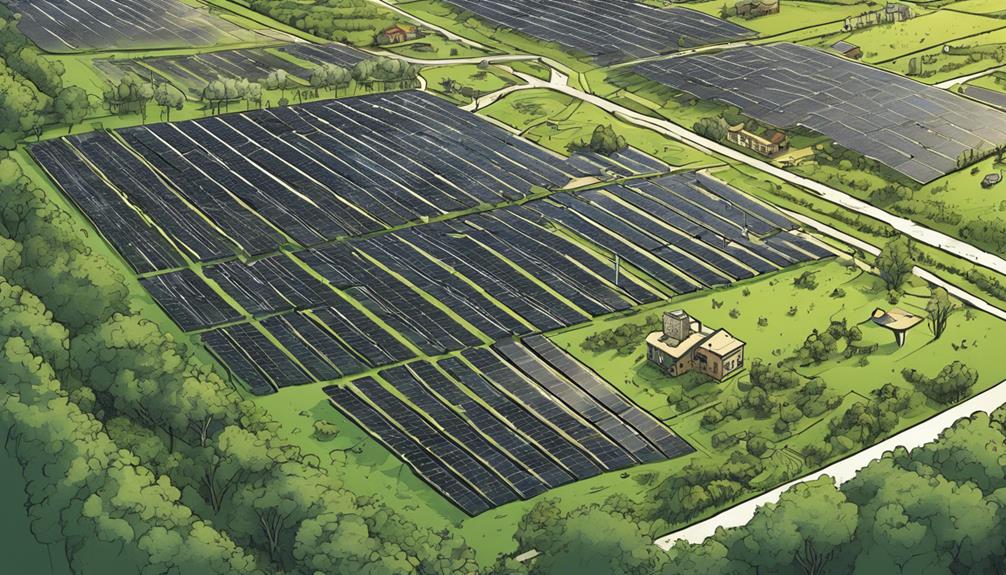
Since 2010, the solar industry has experienced a remarkable 167% job growth, with solar installations contributing billions to local economies through boosted tax revenues, land lease payments, and property values.
As a result, solar farms have become a crucial part of the local economy, generating significant tax revenue for governments and stimulating economic growth. The financial success of solar farms attracts investors, leading to business expansion and creating a cycle of growth and prosperity for communities.
Additionally, solar energy reduces energy costs for local businesses and residents, further stimulating economic growth. By promoting sustainable development and energy independence, solar farms have become a game-changer for local economies.
Job Creation and Training Programs

As the solar industry continues to boom, it's creating a surge in demand for skilled workers, and solar training programs are stepping up to equip individuals with the certifications and hands-on experience needed to succeed in this rapidly growing field. These programs not only provide a pathway to employment but also stimulate local economic activity. By investing in training, we're fostering economic growth and creating a workforce capable of supporting the industry's rapid expansion.
| Training Program | Description |
|---|---|
| Solar Installation | Hands-on training in solar panel installation and maintenance |
| Solar Design | Certification in solar system design and engineering |
| Energy Management | Training in energy management and optimization techniques |
| Business Development | Coursework in solar business development and marketing strategies |
| Workforce Development | Programs focused on workforce development and job placement assistance |
Community Engagement Strategies
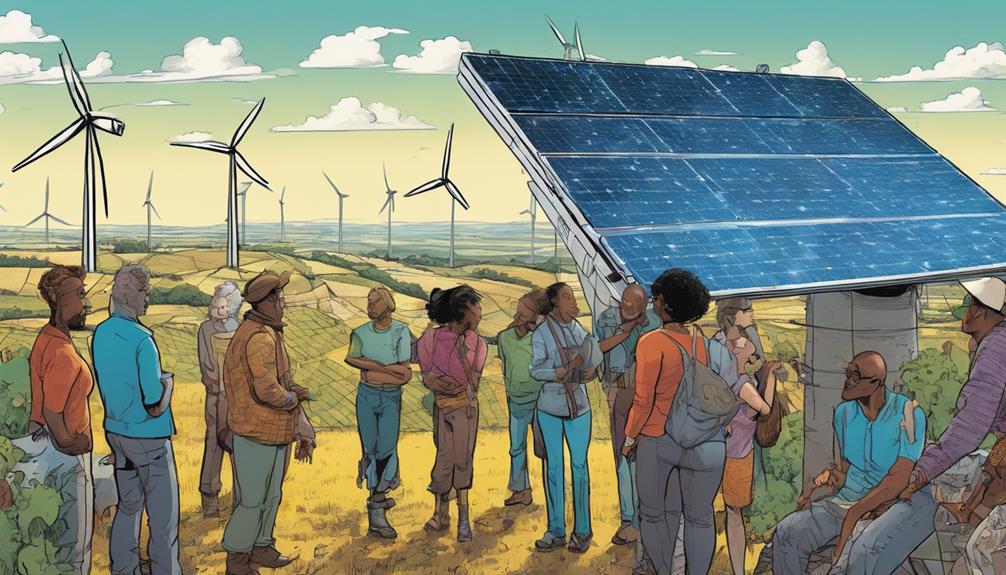
We're building trust and fostering community acceptance through inclusive outreach and stakeholder involvement, pivotal elements in the successful development and operation of solar farms. By engaging the community, we're not only addressing concerns but also educating them about the benefits of solar energy. This collaboration extends throughout the project phases, ensuring that local voices are heard and valued.
Here are some ways we're engaging the community:
- Public events and workshops: Organizing events to raise awareness about solar energy benefits and addressing concerns.
- Partnering with local schools: Collaborating on educational programs to promote solar energy literacy.
- Stakeholder involvement: Engaging community members in decision-making processes for solar farm development.
- Community-owned solar projects: Promoting shared benefits and ownership of solar initiatives.
Solar Energy Innovations
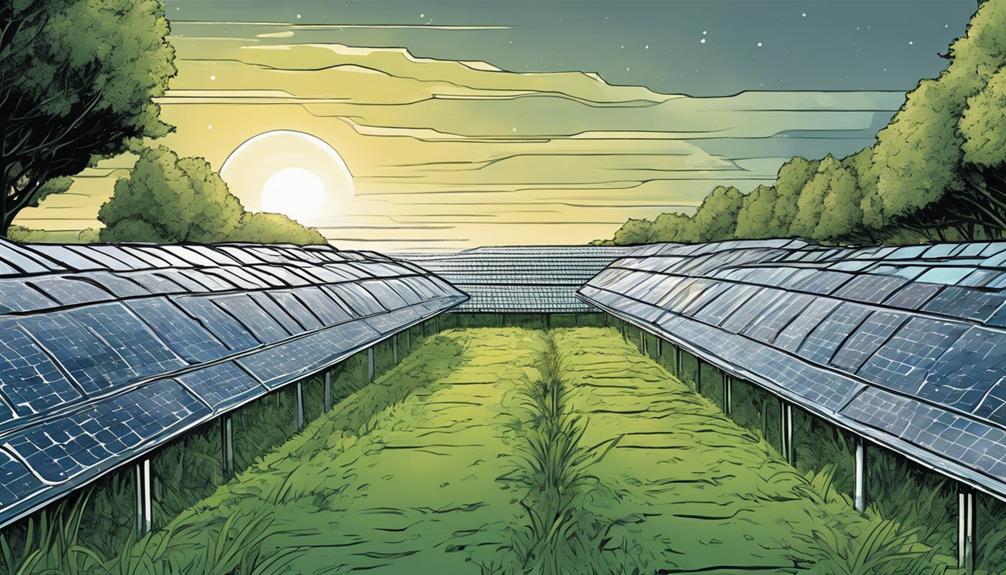
Advances in solar panel materials and designs are dramatically enhancing energy efficiency, paving the way for even more powerful and cost-effective solar farms. As I explore the world of solar energy, I'm struck by the rapid pace of innovation.
Energy storage solutions like batteries are improving solar farm reliability and grid stability, while predictive maintenance techniques are reducing costs and enhancing profitability.
Smart grid integration is optimizing energy distribution, and remote monitoring and control systems are streamlining maintenance and operation.
Artificial intelligence and machine learning algorithms are even being used to optimize solar farm output and performance. These technological advancements are revolutionizing the solar industry, making solar farms an increasingly viable option for communities seeking sustainable energy solutions.
Environmental Sustainability Practices
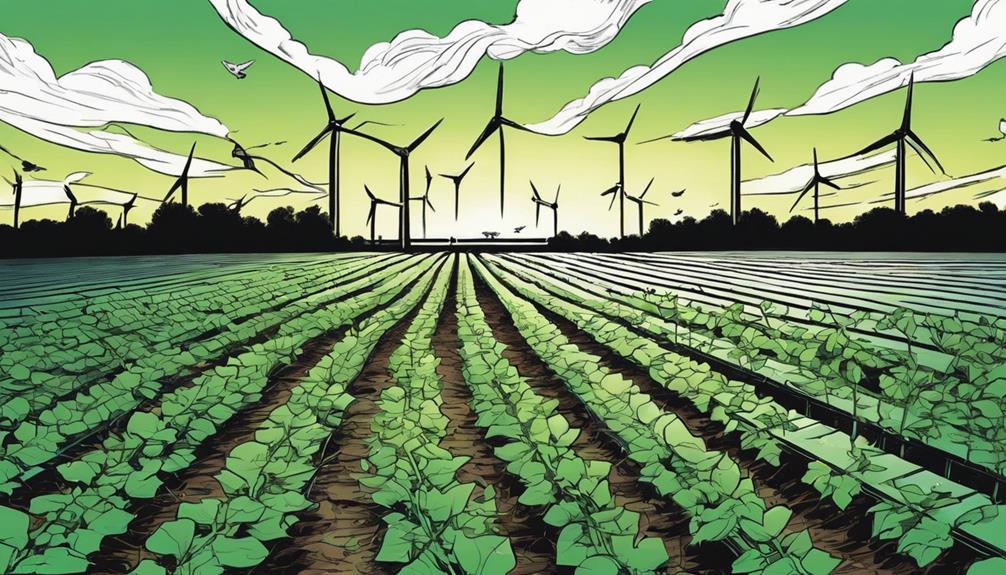
I'm eager to explore how solar farms are incorporating eco-friendly practices into their operations, ensuring a minimal environmental footprint and maximum sustainability. As I dive into the world of solar farms, I'm impressed by the proactive measures taken to reduce their ecological impact.
Here are some innovative practices that stand out:
- Water recycling: Solar farms are implementing water recycling systems to minimize water waste and conserve this valuable resource.
- Land conservation: Solar farms are designed to protect natural habitats and ecosystems, ensuring biodiversity is preserved.
- Light pollution reduction: Solar farms are using specialized lighting designs to minimize light pollution, safeguarding the natural nighttime environment.
- Recycling and proper disposal: Solar farms are dedicated to recycling and appropriately disposing of solar panel components at the end of their lifecycle, reducing electronic waste.
These eco-friendly practices showcase the solar industry's dedication to environmental sustainability.
Social and Economic Impacts

Beyond environmental benefits, solar farms also have a profound impact on local communities, generating significant economic growth and social advantages that resonate throughout the region.
I've seen firsthand how solar farms promote sustainable development and energy independence, creating a cycle of growth and prosperity for communities. The solar industry's remarkable job growth, increased tax revenue, and boosted property values all contribute to local economies.
Additionally, solar energy reduces energy costs for local businesses and residents, stimulating economic growth. By attracting investment and businesses to the area, solar farms create a ripple effect of economic activity, benefiting local governments and services.
It's clear that solar farms are a catalyst for social and economic progress.
Overcoming Financial Barriers
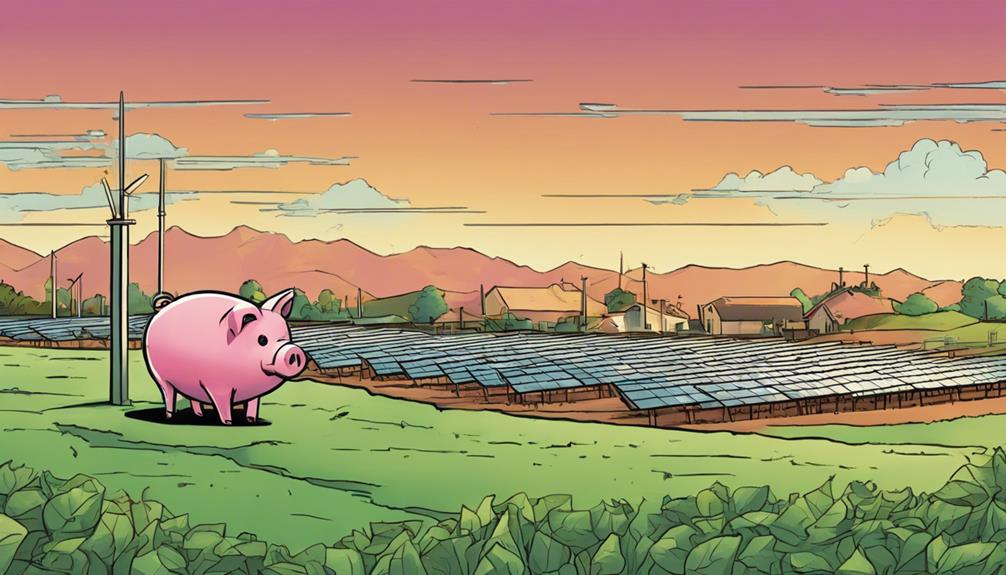
Frequently, financial constraints hinder the adoption of solar energy, particularly in low-income communities and developing countries, where the economic benefits of solar farms are needed most. To overcome these barriers, exploring innovative financing solutions is crucial.
Here are some strategies to keep in mind:
- Government incentives: Offer tax credits, grants, or low-interest loans to encourage investment in solar energy.
- Crowdfunding platforms: Utilize online platforms to raise funds from a large number of people, making solar energy more accessible.
- Community-based financing: Establish community-owned solar projects, where members pool resources to fund solar installations.
- Corporate partnerships: Collaborate with private companies to secure funding and expertise, while sharing benefits and risks.
Best Practices for Success
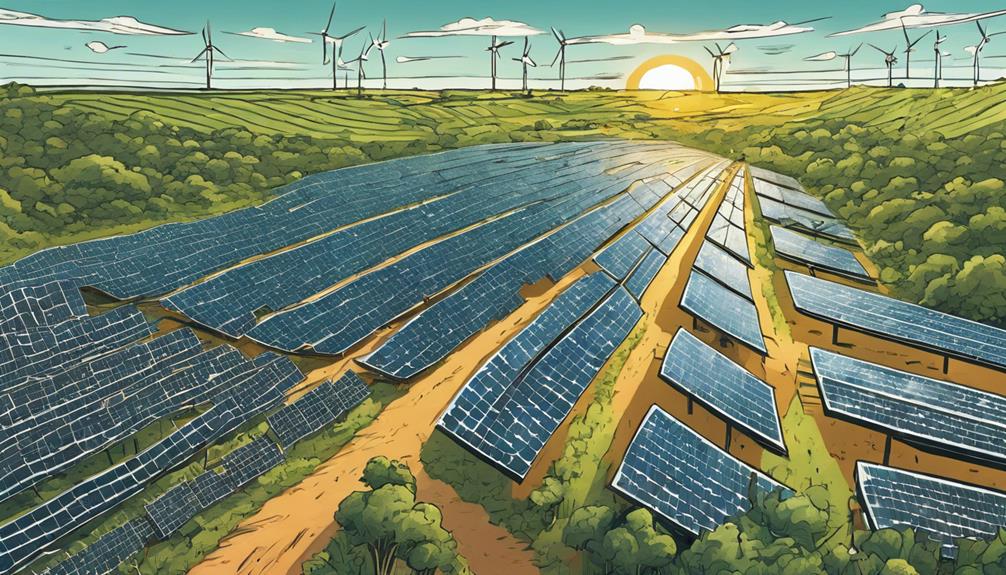
To ensure the successful development and operation of solar farms, adopting best practices that address key aspects of project planning, implementation, and management is essential.
I believe that community engagement and collaboration are necessary for building trust and addressing concerns. Public outreach and stakeholder involvement are crucial throughout project phases.
Additionally, investing in training programs for skilled workers and fostering economic growth through job creation are important. Technological advancements, such as innovations in solar panel materials and energy storage solutions, also play a significant role in optimizing solar farm performance.
Frequently Asked Questions
What Is the Average Lifespan of a Solar Farm?
I'm often asked about the average lifespan of a solar farm. Typically, it's around 25 to 30 years, but with proper maintenance, some farms have been known to last up to 40 years or more.
How Do Solar Farms Affect Local Wildlife Habitats?
"I've found that solar farms can impact local wildlife habitats, but measures like wildlife corridors and habitat restoration can mitigate effects, ensuring a balance between renewable energy and environmental conservation."
Can Solar Farms Be Built on Contaminated Land?
"Who'd have thought that contaminated land, once a liability, could become a valuable asset? Yes, solar farms can be built on contaminated land, and it's a win-win for the environment and local economies."
What Is the Role of Government Incentives in Solar Farm Development?
'I believe government incentives play a pivotal role in solar farm development, as they provide financial support, reduce costs, and stimulate investment, ultimately driving the growth of the solar industry and promoting sustainable development.'
Can Solar Farms Be Used for Agricultural Purposes Simultaneously?
I believe solar farms can be used for agricultural purposes simultaneously, through innovative designs like agrivoltaics, which integrate farming and solar energy production, increasing land-use efficiency and promoting sustainable development.
What Are the Best Practices for Maximizing Efficiency in Solar Farms and How Does It Impact Local Economies?
Maximizing efficiency in solar farms is crucial for reducing operational costs and increasing energy production. Implementing solar farm efficiency strategies such as regular maintenance, proper monitoring, and use of advanced technologies can significantly impact local economies by creating more job opportunities and driving overall economic growth through clean, sustainable energy production.
Conclusion
As I reflect on my journey through the world of solar farms, I'm convinced that these sustainable energy hubs are a game-changer for local economies.
Take, for instance, the town of Greensburg, Kansas, which saw a 10% increase in property values after a solar farm was installed.
By adopting best practices like community engagement and workforce development, solar farms can revolutionize local economies, driving economic prosperity and environmental stewardship.
It's time to harness the power of renewable energy and join the solar revolution.

